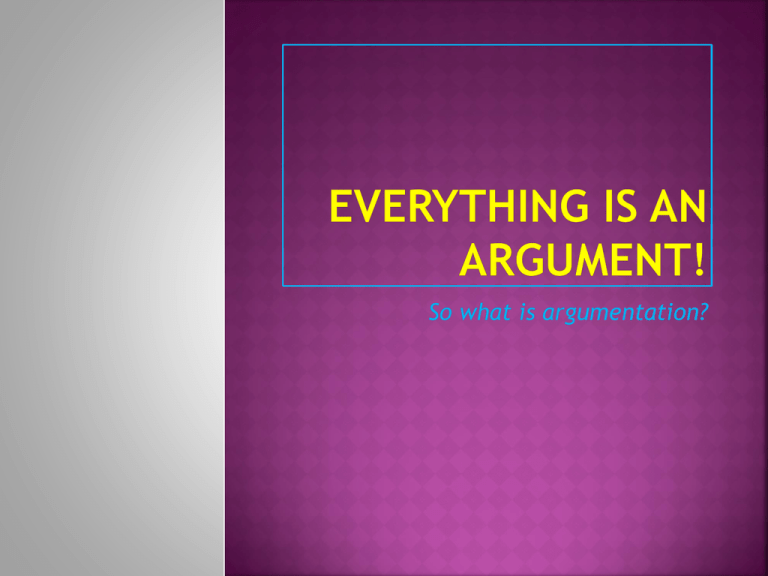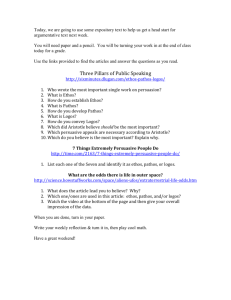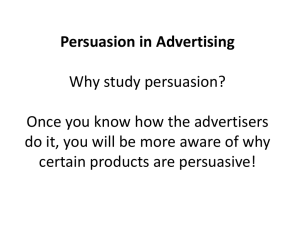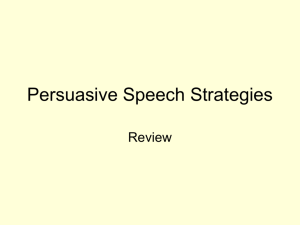What is Argumentation?
advertisement

So what is argumentation? MODES/TYPES of writing Narrative Expository Good Writing = Multiple Modes Persuasive METHODS FORMS Analytical Technical ARGUMENTATIVE METHOD Characteristics : •Clear position established •All ideas are strongly related to position •Controlled, specific reasons and evidence •Writer recognizes opposing or alternate points of view •Persuasive tone throughout Example One: Which is more important: what a person thinks or what a person does Forms: Advertisements Editorials Letters to the editor Persuasive essays Persuasive speeches Propaganda (primarily political) Reviews (books, movies, products) Rhetoric is the power of language and its effects Essence of rhetoric is built upon Aristotle’s Rhetorical Triangle Occasion Tone ETHOS LOGOS L PURPOSE PATHOS Tone Writing well means entering into a conversation with others The underlying structure of effective academic writing – and of responsible public discourse – resides not just in stating our own ideas, but in listening closely to others around us, summarizing their views in a way that they will recognize, and responding with our own ideas in kind What others are saying and thinking motivates our writing and gives it reason for being As a student and a writer you need to enter conversations and debates that surround you Effective persuasive writers do more than make well-supported claims (“I say”); they also map those claims relative to the claims of others (“They say”) Writing asks students not simply to keep proving and reasserting what they already believe, but to stretch what they believe by putting it up against the beliefs of our increasingly diverse, global society, to engage in the reciprocal exchange that characterizes true democracy. Gerald Graff & Cathy Birkenstein It is a mode of writing intended to gain a reader’s agreement using the powers of reasoning and logic. Arguments must be supported by evidence. Evidence may include examples, personal, experience, statistics, research, expert testimony. An argument can be spoken, written or visual as long as it expresses a point of view Point of view is often termed the assertion/claim/thesis. Introduction: Concession: Must state your assertion/claim/point of view/thesis Introduce the ideas that motivate your response (“They say”) Recognize and acknowledge in more depth the opposing point of view Reasons Why do you believe what you believe? Support each reason with evidence Confirmation/Evidence: Research, personal experience, examples, statistics, expert testimony Conclusion (summation): Restate your assertion in response to the ideas of others that motivated you to write your response Amplify your best ideas Offer a solution/compromise (where applicable) The ability to enter complex, many-sided conversations has taken on a special urgency in today’s diverse, post 9/11 world, where the future for all of us may depend on our ability to put ourselves in the shoes of those who think very differently from us. Therefore, we should learn to carefully and effectively listen to others, including those that disagree with us, and then engage with them thoughtfully and respectfully. An ethical or value-based appeal •How to recognize Ethos •Language appropriate to audience •Sincere, fair minded presentation •Correct grammar •The Effect Shows the speaker as a reliable, respectful source through the speaker’s respect for the audience’s values An appeal to emotions • How to recognize Pathos •Emotionally loaded language •Emotional tone •Personal stories •Vivid description • The Effect Creates an emotional, impulsive response An appeal to logic •How to recognize Logos •Factual data and statistics •Definitions •Quotations •Opinions of an expert or authority The Effect Creates a rational, reasonable, logical response What are some examples of ethos that you found? What are some examples of pathos that you found? What are some examples of logos that you found? What is the primary appeal that is made? What are some examples of ethos that you found? What are some examples of pathos that you found? What are some examples of logos that you found? What is the primary appeal that is made? What are some examples of ethos that you found? What are some examples of pathos that you found? What are some examples of logos that you found? What is the primary appeal that is made? “They Say” “I Say” by Gerald Graff & Cathy Birkenstein Argumentation – Basic Training by Elizabeth Villarreal Occasion Tone ETHOS LOGOS L PURPOSE PATHOS Tone





